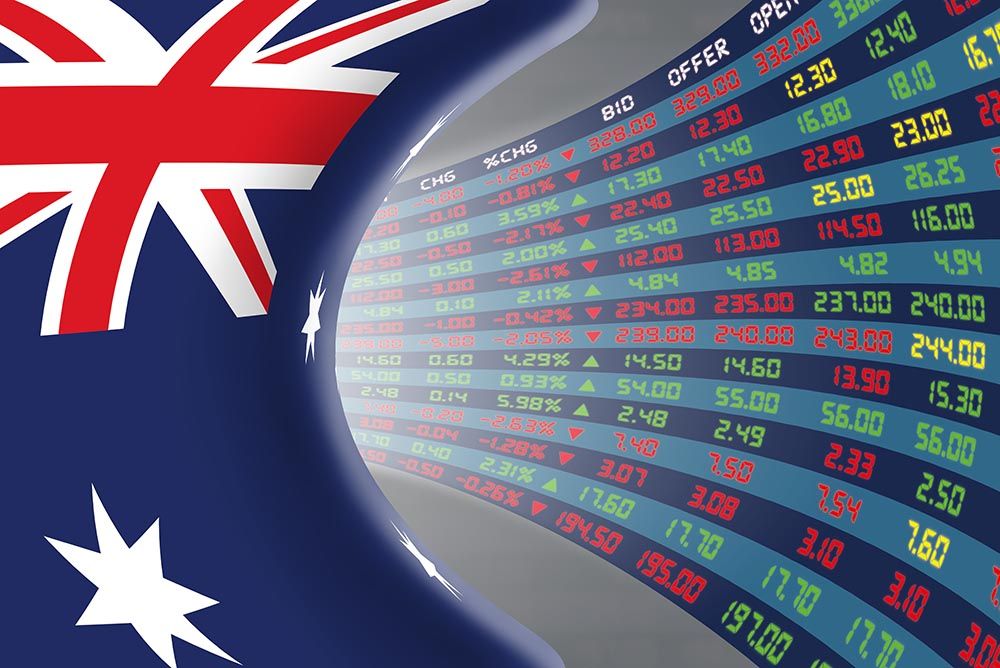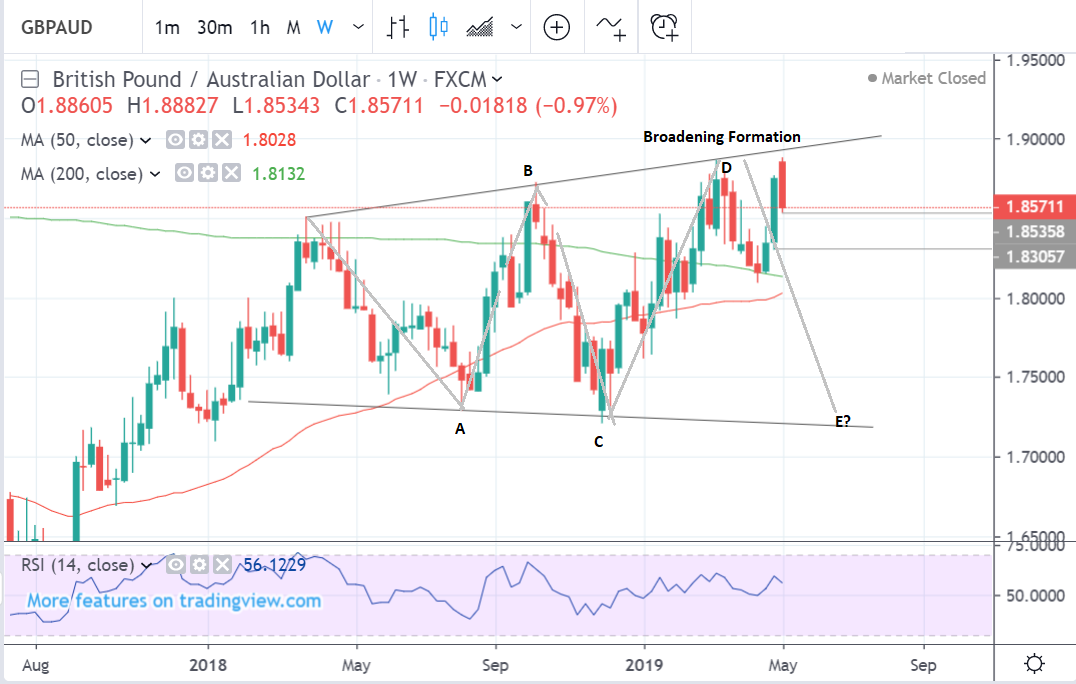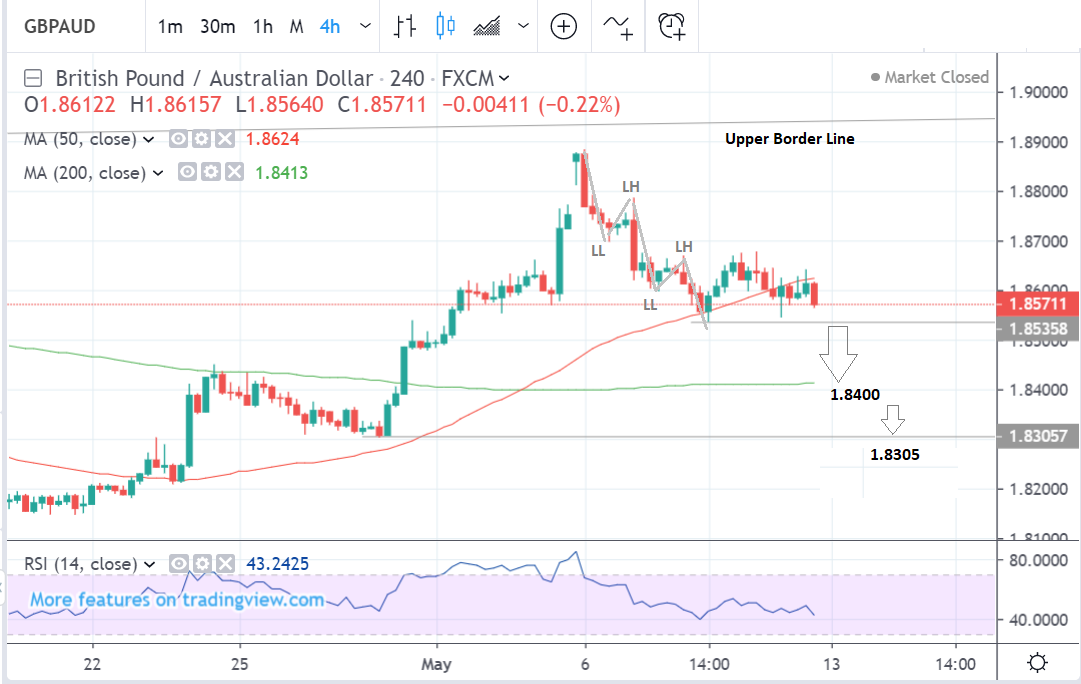Pound-to-Australian-Dollar Rate in the Week Ahead: Trend Reversal to Downside Now Underway

Image © William W. Potter, Adobe Stock
- GBP/AUD’s short-term trend rotates lower.
- Bearish long-term chart pattern remains in place.
- Pound to be driven by Brexit debate; Aussie by RBA.
The Pound-to-Australian-Dollar rate is trading at 1.8648 at the start of the new week, a decent 0.45% higher than where it closed the previous week. The Pound has been under pressure against the Australian of late, having falling more than one percent last week, and the exchange rate might see further losses in the days ahead because the short and long-term trends are now both to the downside.
Sterling ceded ground to most of its G10 rivals last week due to an absence of progress in the cross-party Brexit talks, with weakness egged on by reports that Nigel Farage’s Brexit Party is leading in the opinion polls ahead of the EU elections set for May 23rd.
The meteoric rise of the Brexit Party in the polls could make agreeing a deal between the two largest parties in Westminster more difficult, and therefore the prospect for a summer of political uncertainty looks to be high.
.png)
Above: GBP/AUD rate shown at weekly intervals.
From a technical perspective, the pair appears to have reversed the fledgling uptrend that had been establishing itself since the middle of April. The point at which the uptrend reversed corresponds with a trendline drawn connecting the March 2018, October 2018 and March 2019 highs.
This is the fourth touch of the above trendline, which is a bearish sign. It could also be the upper border line of a broadening formation, which is a bearish reversal pattern. In short, last week's pivot lower may have further to go.

Above: GBP/AUD rate chart showing broading formation.
The 4-hour chart reveals further evidence that the short-term trend is turning bearish. The pair has formed more than two sets of lower lows (LL) and lower highs (LH) - one of the signs analysts use to evidence the start of a new trend.
A break below the 1.8535 May 8 low would provide confirmation of a further move to the downside being in the pipeline, likely targeting 1.8400 followed by 1.8305.

Above: GBP/AUD rate shown at 4-hour intervals.
AA
Time to move your money? Get 3-5% more currency than your bank would offer by using the services of foreign exchange specialists at RationalFX. A specialist broker can deliver you an exchange rate closer to the real market rate, thereby saving you substantial quantities of currency. Find out more here.
* Advertisement
The Australian Dollar: What to Watch this Week
Global factors will remain a likely driver for the Aussie over coming days, with markets keeping an eye on U.S.-China trade talks which deteriorated last week to the extent that the U.S. went ahead and levied addition tariffs on Chinese imports.
However, both sides remain at the negotiating table, and there remains some hope talks will deliver the progress required to pull the two sides from an all-out trade war that will knock global economic growth.
If the situation escalates the Aussie Dollar could well be one of the G10 currency spaces main victims owing to Australia's strong trade links with China: a slowing China would almost certainly have knock-on effects for Australian exports.
"With the U.S. threatening further tariffs, we await the proposed Chinese retaliatory reaction this week, along with key Chinese data for indications on whether its economy is strong enough to weather future negative impacts from a trade slowdown," says Robin Wilkin, a cross-asset strategist with Lloyds Bank.
"This week AUD will be buffeted by the U.S. and Chinese influences as well as the key Australian labour reports. Last week’s RBA communications increased the importance of labour market indicators in its interest rate decisions," says Kim Mundy, a foreign exchange strategist with CBA in Sydney.
The main domestic data release for the Australian Dollar is labour market data, which is expected to show the unemployment rate remaining unchanged at 5.0% and employment change to show a 15.2k rise in the number of jobs added, when the data is released at 2.30 BST on Thursday, May 16.
The Australian labour market has traditionally been quite strong and in the recent monetary policy statement the Reserve Bank of Australia (RBA) highlighted ongoing labour market strength as key to the outlook for interest rates.
Interest rates are a major driver of currencies, to which they are positively correlated. If interest rates rise it usually causes a corresponding rise in the currency, because higher interest rates tend to attract and keep greater inflows of foreign capital. The opposite happens if interest rates fall.
A stronger labour market has so far prevented the RBA from cutting interest rates which has supported the Aussie so as long as the labour market maintains that strength the Aussie should also stay supported. The opposite is the case is the case if labour market data worsens.
The Westpac consumer sentiment gauge is another key release for the Aussie. It is scheduled for release at 1.30 on Tuesday.
Speeches by Guy Debelle, the deputy governor of the RBA at 8.00 on Monday and by assistant governor Bullock on Thursday at 3.45 may also impact on the Aussie.
The Pound: What to Watch
The main economic release out for the Pound this week is March jobs data. The UK labour market has been resilient in the face of political and economic uncertainty of late and if that idea is reinforced again this week then the Pound might benefit.
A strong labour market can mean rising wages, increased inflation and higher interest rates further down the line, which could then lead to a stronger Pound because currencies tend to rise and fall with interest rates.
February’s figures were especially good after they showed the unemployment rate remaining at only 3.9% and some 179k new jobs being created. March is expected to have seen the unemployment rate remain steady.
Average earnings growth is expected to be a slightly lower than in February, coming in at 3.4% annualised, down from 3.5% previously.
“The UK jobs market has been fairly resilient even though economic growth has slowed notably from the ongoing Brexit uncertainty,” says Raffi Boyadijian, economist at FX broker XM.com. “Wage growth in the UK is currently at a 10-year high, which is good news for consumers who have been the main drivers of the British economy amid weakening overseas demand and falling business investment from Brexit.”
Brexit continues to be a major risk factor for the Pound, which could see loses in the week ahead if tenuous cross-party talks breakdown.
A rise in support for Nigel Farage’s Brexit Party, which is leading in the polls with 34% of the electorate ahead of the May 23rd vote, may mean it's less likely Theresa May will secure support for her Brexit plan from the opposition Labour Party. This leaves the risk of a general election alive and well.

Above: UK opinion poll outcome. Source: The Guardian.
Time to move your money? Get 3-5% more currency than your bank would offer by using the services of foreign exchange specialists at RationalFX. A specialist broker can deliver you an exchange rate closer to the real market rate, thereby saving you substantial quantities of currency. Find out more here.
* Advertisement




